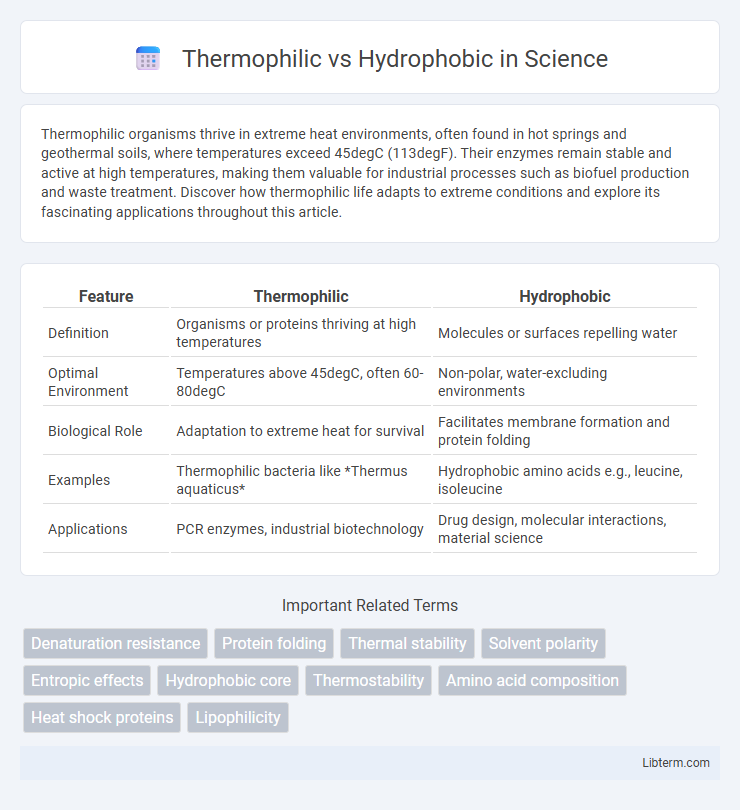Thermophilic organisms thrive in extreme heat environments, often found in hot springs and geothermal soils, where temperatures exceed 45degC (113degF). Their enzymes remain stable and active at high temperatures, making them valuable for industrial processes such as biofuel production and waste treatment. Discover how thermophilic life adapts to extreme conditions and explore its fascinating applications throughout this article.
Table of Comparison
| Feature | Thermophilic | Hydrophobic |
|---|---|---|
| Definition | Organisms or proteins thriving at high temperatures | Molecules or surfaces repelling water |
| Optimal Environment | Temperatures above 45degC, often 60-80degC | Non-polar, water-excluding environments |
| Biological Role | Adaptation to extreme heat for survival | Facilitates membrane formation and protein folding |
| Examples | Thermophilic bacteria like *Thermus aquaticus* | Hydrophobic amino acids e.g., leucine, isoleucine |
| Applications | PCR enzymes, industrial biotechnology | Drug design, molecular interactions, material science |
Introduction to Thermophilic and Hydrophobic Properties
Thermophilic organisms thrive at high temperatures, exhibiting proteins and enzymes optimized for stability and function in extreme heat environments such as hot springs or deep-sea hydrothermal vents. Hydrophobic properties refer to the tendency of molecules or surfaces to repel water, characterized by nonpolar groups that minimize interaction with aqueous environments, essential for membrane formation and protein folding. Understanding thermophilic adaptation and hydrophobic interactions is crucial for applications in industrial biotechnology, including biocatalysis under harsh conditions and development of water-resistant materials.
Defining Thermophilic: Heat-Loving Organisms
Thermophilic organisms thrive in high-temperature environments, typically between 45degC and 122degC, utilizing heat to sustain their metabolic processes. These heat-loving microbes are often found in geothermal habitats such as hot springs, hydrothermal vents, and compost piles, demonstrating enzymes optimized for stability and activity under extreme heat conditions. Their ability to maintain cellular function at elevated temperatures contrasts sharply with hydrophobic adaptations, which pertain to water-repellent properties rather than thermal tolerance.
Understanding Hydrophobic: Water-Repelling Traits
Hydrophobic materials exhibit water-repelling traits due to their non-polar molecular structure, which prevents water molecules from adhering to their surface, making them crucial in waterproof coatings and biological membranes. These water-repellent characteristics enhance durability and resistance to moisture, reducing corrosion and biofouling in industrial and environmental applications. Understanding hydrophobicity is essential for developing advanced textiles, self-cleaning surfaces, and efficient fluid separation technologies.
Thermophilic vs Hydrophobic: Key Differences
Thermophilic organisms thrive in high-temperature environments, typically between 45degC and 80degC, while hydrophobic substances repel water and tend to associate with nonpolar molecules. Thermophilicity relates to an organism's adaptation to extreme heat through specialized enzymes and membrane stability, whereas hydrophobicity describes molecular interactions driven by water avoidance. Understanding these differences is crucial in applications like biotechnology, where thermophilic enzymes offer heat resistance and hydrophobic materials provide water repellency.
Biological Significance of Thermophilic Adaptations
Thermophilic adaptations enable organisms to thrive in extreme high-temperature environments by stabilizing proteins and cellular structures, enhancing enzyme functionality at temperatures above 45degC. These adaptations include reinforced hydrogen bonding, increased hydrophobic core packing, and specialized chaperone proteins that prevent denaturation, crucial for maintaining metabolic processes in geothermal habitats. Understanding thermophilic mechanisms informs biotechnology applications such as industrial enzymes and PCR techniques, leveraging thermostability for enhanced efficiency and robustness.
Applications of Hydrophobic Materials in Science
Hydrophobic materials play a crucial role in science due to their ability to repel water, making them ideal for applications such as anti-corrosion coatings, self-cleaning surfaces, and water-resistant textiles. These materials enhance the efficiency of water-repellent membranes used in filtration and desalination technologies, contributing significantly to environmental engineering. Advanced hydrophobic surfaces also improve lab-on-a-chip devices by controlling fluid flow through microchannels, enabling precise biomedical diagnostics.
Environmental Factors Influencing Thermophilicity
Thermophilicity is primarily influenced by environmental factors such as temperature, pH, and nutrient availability, which determine the survival and growth of thermophilic organisms in hot environments like geothermal springs and compost heaps. In contrast, hydrophobicity relates to an organism's ability to repel water, often impacting its interaction with surfaces and biofilm formation rather than temperature adaptation. Understanding how high-temperature conditions affect protein stability and membrane composition is crucial for studying thermophilic adaptations in extreme environments.
Role of Hydrophobicity in Industrial Processes
Hydrophobicity plays a crucial role in industrial processes by enhancing the stability and activity of enzymes under harsh conditions, such as high temperatures and organic solvents. Thermophilic enzymes, which originate from heat-loving microorganisms, often exhibit strong hydrophobic interactions that contribute to their thermal stability and resistance to denaturation. This characteristic allows hydrophobic enzyme surfaces to minimize water interference, improving catalytic efficiency in biocatalysis, pharmaceuticals, and biofuel production.
Comparison Table: Thermophilic vs Hydrophobic Characteristics
Thermophilic organisms thrive at high temperatures, typically between 45degC and 122degC, exhibiting specialized enzymes that maintain stability and function under extreme heat, whereas hydrophobic substances repel water due to nonpolar molecular structures. Thermophilic traits include heat tolerance, enzyme thermostability, and adaptation to thermal environments, contrasting with hydrophobic characteristics like water repellency, low polarity, and affinity for non-aqueous environments. Thermophilic organisms are commonly found in hot springs and hydrothermal vents, while hydrophobic materials are prevalent in oils, waxes, and cell membrane lipid bilayers.
Future Trends in Thermophilic and Hydrophobic Research
Future trends in thermophilic research emphasize engineering microbial enzymes for high-efficiency biofuel production and waste remediation under extreme temperatures, driven by advances in protein engineering and metagenomics. Hydrophobic material studies are increasingly focused on developing self-cleaning surfaces and water-repellent coatings for industrial and biomedical applications, leveraging nanotechnology and bioinspired design. Integration of thermophilic biological systems with hydrophobic interfaces presents promising opportunities for next-generation bioprocessing and durable materials in harsh environmental conditions.
Thermophilic Infographic

 libterm.com
libterm.com